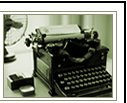Facts and Trivia
The First Underwood
In 1894, Franz Wagner and his brother patented a visible front-stroke design typewriter, soon afterward known as the Underwood. In this machine, they overcame the deficiencies of the previous attempts by other inventors and immediately established a formidable presence in the typewriter field.
The business world quickly recognized the desirability, practicality and advantage of the Underwood - the first successful front-stroke visible-writing machine and the one which revolutionized typewriter industry. Manufacturers of old style machines were ultimately forced to produce new models sharing similar principles of the successful Underwood Typewriter. Since that time, every new typewriter placed on the market has been a visible-writing machine.
During the first decade of the 20th century, the most popular frontstroke machine was the Underwood No. 5, which won many speed typing contests. Underwood sold nearly four million of its No. 5 and its similar No. 3 and No. 4 typewriters between 1901 and 1931. Another front strike typewriter brand that is often recognizable because of its distinctive shape is the flatbed Royal No. 5, which was introduced in 1906. A unique typewriter that was popular in offices during the 1900s and 1910s was the Oliver Visible Typewriter, a downstroke model. Over 1 million Olivers were sold during the 32 years (1894-1926)
In contrast to the nearly 100 American companies that produced typewriters in earlier decades, by the 1920s the US typewriter industry had substantially consolidated. During the 1920s and 1930s, the big four frontstroke typewriter companies--Underwood, Royal, Remington and Smith-Corona--accounted for 80% of the dollar value of typewriters sold in the US. Underwood had a 50% market share in 1920 but later lost ground to Royal. By 1944, the four companies made 95% of all American typewriters and had been accused of conspiring to fix prices.
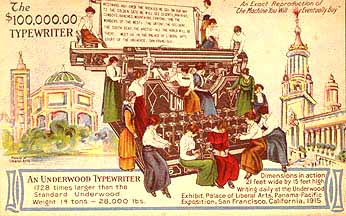
Underwood No. 5 - The $10,000 Typewriter |
|
|
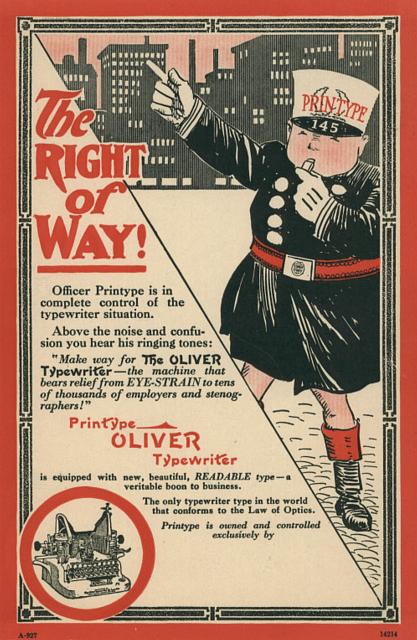
Oliver No 5 in PrintType |
|
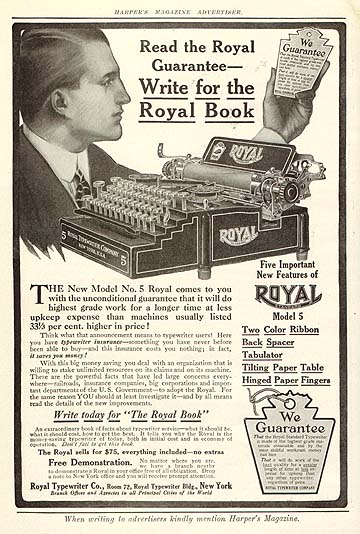
Royal No. 5 |
--------------------------------------------------------------------------------------------------------------------------------
Portables
In the early 1900s, typewriter companies began to actively pursue consumers directly with lightweight, compact, and inexpensive portable machine. While some small typewriters had been introduced prior to 1900, most were index machines and consequently slower than those with a keyboard. In general, manufacturers considered these typewriters to be entry level products which would eventually lead to increased sales of office models.
However, portables became the preferred category for individuals, and even now, many people are reluctant to give them up! The first commercial viable portable hit the market in 1906: The Corona folding portable, based on the Standard Folding. Corona's advertising at the time claimed that the portable typewriter increased the market for typewriters by as much as fifty times, since every individual and not simply every business was now a prospect.
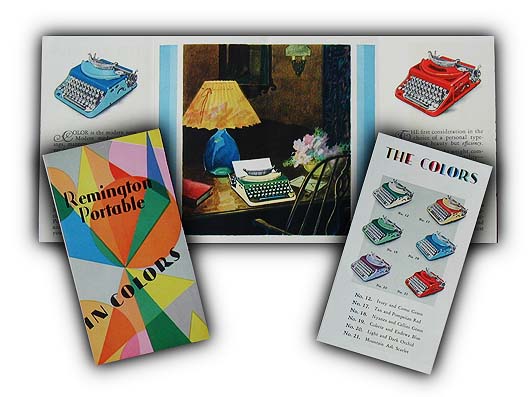
Portables foreshadowed the personal laptop computer in many ways; the idea of an on-the-go workstation for business or personal use and correspondence really began with the portable typewriter. In the 1926s Royal debut it first portable in many attractive colors, aimed to target home market. 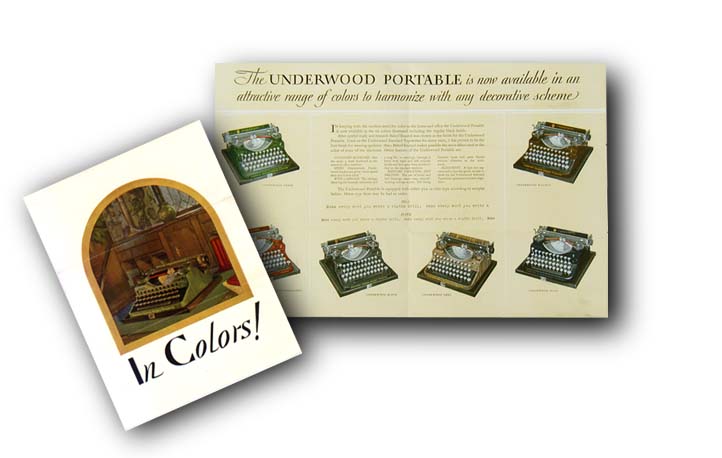
In designing the portable, manufacturers had to make many changes in order to achieve reasonably good quality typed print at an affordable price. They cut costs and made the machine lighter in weight by simplifying the typewriter's workings: mechanisms were less complex and parts were made by different methods to reduce cost and streamline the machines. One area of additional expense in the production of portables was the case -- almost all portable models had one.
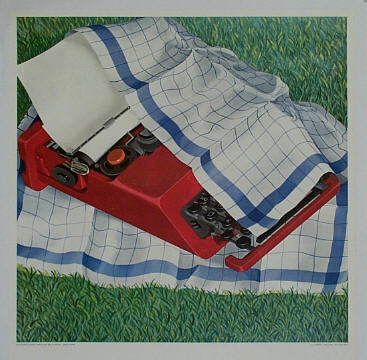 Unlike standard office models, portable were sold incidentally sold through branches and majority of them were sold by dealers from department stores, book and stationery stores and credit jewelers. After WWII, the annual production of portables equaled that of office typewriters. Unlike standard office models, portable were sold incidentally sold through branches and majority of them were sold by dealers from department stores, book and stationery stores and credit jewelers. After WWII, the annual production of portables equaled that of office typewriters.
---------------------------------------------------------------------------------------------------------------------------------Women and the Typewriter
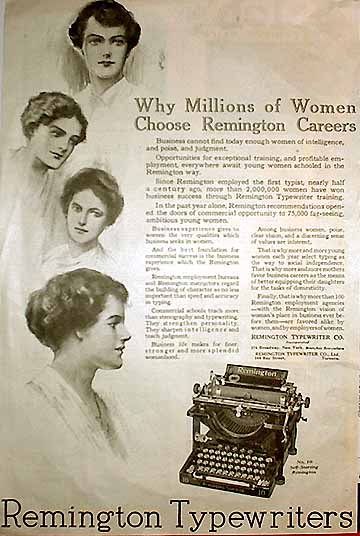 Typewriters can be credited with changing the entire social order -- it was the writing machine that opened the doors of business to women. Beginning as early as 1881, there were new opportunities dawning for women; the YWCA began offering typing classes to women, and by a short five years later, there were an estimated 60,000 women working as typists in business offices. Typewriters can be credited with changing the entire social order -- it was the writing machine that opened the doors of business to women. Beginning as early as 1881, there were new opportunities dawning for women; the YWCA began offering typing classes to women, and by a short five years later, there were an estimated 60,000 women working as typists in business offices.
Certainly, the need for women to enter the work force to replace men during two world wars created massive change in norms, but it was the typewriter that brought women into business in a way that would help them achieve economic freedoms for the first time.
An illustration from the book The History of the Typewriter 1873-1923 shows this illustration of Christopher Sholes as a kind of celestial hero who delivered women from their deadend lives:
--------------------------------------------------------------------------------------------------------------------------------Typewriters and War
During the years of World War I, 1914 - 1918, typewriter production nearly halted. The major producer of typewriters at that time, Remington, had formerly been in the munitions industry, so when war came their facilities were almost entirely reconverted to the task of building arms and ammunition.
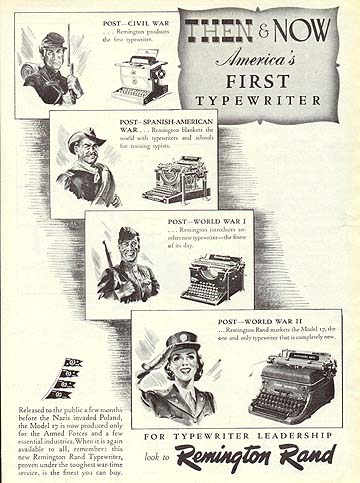
Right in the trenches, however, portable typewriters were in use by British Forces. Thousands of American Corona portables were used for reporting on the ground and in patrol aircraft, and it is known that many important wartime documents were produced on portable Coronas. For instance, the surrender papers for German South West Africa were typed and duplicated on a Corona typewriter.
When American entered World War II, production on all American typewriters stopped in order for factories to dedicate their output to essential war munitions -- with one exception. The Woodstock company was authorized to produce 18,000 typewriters a year. This led to a strange requisition order: the American Government requested that all spare typewriters be turned over to the military. Manufacturers, retailers, and even private citizens were urged to give up their typewriters.
--------------------------------------------------------------------------------------------------------------------------------
Typewriter Pricing
The unanimity about typewriter prices was noticeable as the typewriter industry became mature. For in 1939, the Department of Justice indicted Royal, Underwood, Remington and Smith-Corona, charging that since 1930 they had conspired to fix prices and increase them simultaneously, to make identical bids, to establish uniform trade-in allowances as well as other monopolistic acts that restrained trade. In 1940, the four companies consented, without admitting any guilt, to a court decree that forbids them to any above and forbids them to merge or to acquire stock in each other’s companies or any other typewriter company. One possible explanation for the lack of price differentiation of these companies was not because of collusion but simply because no company could afford not to meet the price of a competitor.
There were about 25 direct labor in a typewriter while material cost of the typewriter was relatively low. According to an article in Fortune magazine in 1944, prior to WWII, the typewriter manufacturing and assembling costs of an office machine were about $35 – of which about $6 was for material and $14.50 for labor and the same for factory overhead. Retail price was $115.50. The dealer, whose discount was 40%, theoretically, had spread of $46.20. But, two-thirds or more sales of new typewriters involved trade-ins, the dealer sometimes reduced margins to ensure sales. In addition, the big-volume business often received discount.
|


